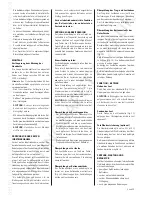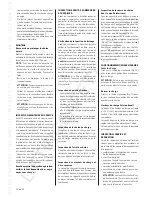
6 von 20
- If the hoist is to be used for frequent lowering
from large heights or in indexed operation,
fi rst consult the manufacturer for advice
because of possible overheating.
- The top hook and the load hook of the unit
must be in a vertical line above the load
centre of gravity (S) when the load is lifted,
in order to avoid load sway during the lifting
process (Fig. 1).
- The selection and calculation of the appropri-
ate supporting structure are the responsibil-
ity of the operating company.
- The operator must ensure that the hoist is
suspended in a manner that makes it pos-
sible to operate the unit without exposing
himself or other personnel to danger by the
unit itself, the suspension or the load.
- The operator may start moving the load only
after it has been attached correctly and all
persons are clear of the danger zone.
- Do not allow personnel to stay or pass under
a suspended load.
- A lifted or clamped load must not be left
unattended or remain lifted or clamped for
a longer period of time.
- The hoist may be used at ambient tempera-
tures between –10 °C and +50 °C.
Consult the manufacturer in the case of
extreme working conditions.
ATTENTION:
Before use at ambient tem-
peratures of less than 0 °C, check the brake
for freezing by lifting and lowering a small
load 2 - 3 times.
- Prior to operation of the hoist in special
atmospheres (high humidity, salty, caustic,
alkaline) or handling hazardous goods (e.g.
molten compounds, radioactive materials),
consult the manufacturer for advice.
- Always transport the load in the horizontal
direction slowly, carefully and close to the
ground.
- When the unit is not in use, position the
suspension (e.g. bottom block, load hook)
above normal head height, if possible.
- For attaching a load, only approved and
certifi ed lifting tackle must be used.
- Correct operation involves compliance with
the operating instructions and in addition
also compliance with the maintenance
instructions.
- In case of functional defects or abnormal
operating noise, stop using the hoist
imme-
diately
.
INCORRECT OPERATION
(List not complete)
- Do not exceed the rated load capacity (WLL)
of the unit and/or the suspension and the
supporting structure.
- The unit must not be used for pulling free
fi xed loads. It is also prohibited to allow loads
to drop when the chain is in a slack condition
(danger of chain breakage).
- Removing or covering labels (e.g. by adhe-
sive labels), warning information signs or the
identity plate is prohibited.
- When transporting loads ensure that the load
does not swing (Fig. 2) or come into contact
with other objects.
- The load must not be moved into areas which
are not visible to the operator. If necessary,
he must ensure he is given help.
- Driving the unit with a motor is not allowed.
- The unit must never be operated with more
than the power of a person.
- Welding on hook and load chain is strictly
forbidden. The load chain must never be
used as a ground connection during welding
(Fig. 3).
- Side pull, i. e. side loading of either the hous-
ing or the bottom block (Fig. 4) is forbidden.
- The load chain must not be used as a chain
sling (Fig. 5).
- A unit changed without consulting the
manufacturer must not be used.
- Do not use the hoist for the transportation
of people (Fig. 6).
- Do not knot the load chain or connect it by
using pins, bolts, screw drivers or similar. Do
not repair load chains installed in the hoist
(Fig. 7).
- Removing the safety latches from top and/
or load hooks is forbidden (Fig. 8).
- Never attach the load to the tip of the hook
(Fig. 9). The lifting tackle must always be
seated in the saddle of the hook.
- Do not use the chain stop (Fig. 11) as an
operational limit device.
- Turning of loads under normal operating
conditions is not allowed, as the bottom
blocks of the hoists are not designed for this
purpose. If loads must be turned in normal
operation, an anti-twist swivel must be used
or the manufacturer must be consulted.
- Only one load lifting attachment may be
suspended in the load hook of the hoist.
- Never reach into moving parts.
- Do not allow the unit to fall from a large
height. Always place it properly on the
ground.
- The unit must not be used in potentially
explosive atmospheres.
ASSEMBLY
Shorten or extend the hand chain
Adjust the length of the hand chain so that
the distance of the lower end to the fl oor is
between 500 – 1000 mm.
Note:
For safety reasons, hand chain links
may only be used once.
- Look for the non-welded link of the hand
chain, bend to open and discard it.
- Shorten or extend the chain to the required
length.
ATTENTION:
Always remove or add an even
number of chain links.
- Use a new link to close the loose chain ends
by bending it (for extending the hand chain,
two new chain links are required).
ATTENTION:
Do not twist hand chains while
fi tting.
INSPECTION BEFORE INITIAL
OPERATION
Prior to initial operation, before it is put
into operation again and after substantial
changes, the product including the supporting
structure must be inspected by a competent
person*. The inspection mainly consists of a
visual inspection and a function check. These
inspections are intended to establish that the
hoist is in a safe condition, has been set up
appropriately and is ready for operation and
that any defects or damage are detected and
eliminated, as required.
*Competent persons may be, for example, the
maintenance engineers of the manufacturer or
the supplier. However, the company may also
assign performance of the inspection to its
own appropriately trained specialist personnel.
Before putting the unit into operation,
check functioning of the chain drive in
unloaded condition.
INSPECTIONS BEFORE STARTING
WORK
Before starting work, inspect the unit including
the suspension, equipment and supporting
structure for visual defects, e. g. deformations,
damage, cracks, wear and corrosion marks.
In addition also test the brake and check that
the hoist and the load are correctly attached.
Checking the brake function
Before starting work, always check operation
of the brake:
To do this, lift, pull or tension and lower or
release a load over a short distance with the
unit. When the hand chain is released, the
load
must
be held in any position.
This check is intended to ensure that even
at temperatures below 0 °C, the brake disks
are not frozen. Repeat it at least twice, before
starting further work.
ATTENTION:
If the brake does not function
properly, the unit must be immediately taken
out of service and the manufacturer must
be contacted!
Summary of Contents for VSIII 0
Page 17: ...17 von 20...




























